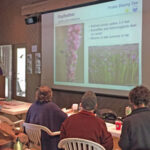About this Program
Richard Louv in Last Child in the Woods points out that baby boomers are the last generation of Americans to share an intimate, familial attachment to the land and water. The importance of nature to our well-being has been demonstrated by numerous studies correlating improved learning, an increased sense of well-being, and reduced crime in neighborhoods with trees and parks.
The Native Plant Society of Texas created the Native Landscape Certification Program (NLCP) to encourage a migration of Texans back to nature that will reap priceless benefits for our families, environment, and economy.
NLCP is a series of day-long classes that teach best practices for native plant landscaping – including wildlife habitat gardening. Each class consists of an indoor training session and a plant identification section. We show you plants native to the local ecoregion, illustrating their use in the landscape. You will also see common non-native plants which may take over our natural areas. In each level you are presented 45 native Texas plants recommended for your landscape and 5 plants to avoid. Classes are adapted to the area in which they are offered.
Targeted audiences include homeowners, native plant enthusiasts, landscape architects, architects, landscape designers, nursery and landscape maintenance employees, park employees, Master Naturalists, Master Gardeners, teachers, and other interested paries.
We look forward to working with you to increase your appreciation and use of native plants in landscapes, including
- emphasizing a sense of place for residents and visitors,
- increasing the presence of desirable wildlife species,
- reducing the use of water and other precious resources, and
- enhancing and protecting our natural world.
NLCP is a state-wide program, but classes focus on the characteristics and plants of the region in which they are taught. Please register for classes located in the region in which you wish to landscape.
Steering Committee
Since 2014, the Native Landscape Certification Program has been run by a Steering Committee reporting to the State Board of the Native Plant Society of Texas. Day to day operations are handled by an NLCP Coordinator under the guidance of the Steering Committee.
The Steering Committee meets regularly, usually once a month. If you would like to contact the Steering Committee about a concern or an idea, please use the form below and note that you are directing the message to the Steering Committee.
| Linda Foss | Coordinator |
| Bill Hopkins | Chair |
| Joan Miller | |
| Kathy Herrick | |
| Margaret Gnewuch | |
| Meg Inglis | |
| Patrick Garnet | |
| Amy Birdwell | ex officio |
| Laura Legett | ex officio |
| Ricky Linex | ex officio |
Resources
Program Handbook
The Program Handbook provides a program overview and outlines steps to take when implementing classes in your area. It is intended for use by instructors, hosting organizations and anyone assisting with classes. You can download a PDF copy for your own use from our server.
Download a copy of the program Handbook
Strategic Planning
In the Summer of 2021 the NLCP Steering Committee held planning meetings and adopted a Strategic Plan with goals for the the next three years.
Download a copy of the NLCP Strategic Plan
Contact Native Landscape Certification Program
To learn more about the landscaping program and scheduled classes, please contact Linda Foss, NLCP Coordinator.

